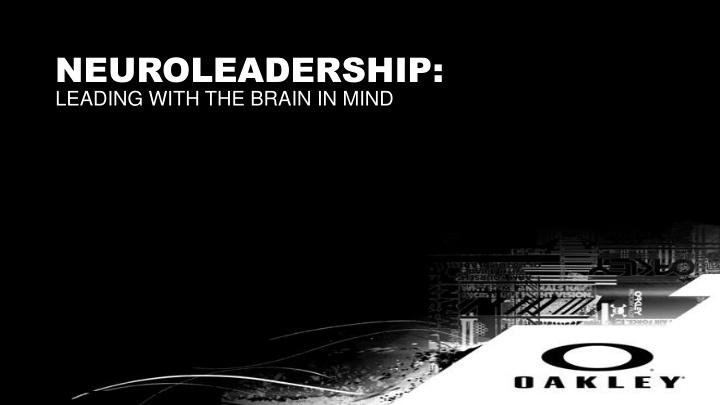



NEUROLEADERSHIP: LEADING WITH THE BRAIN IN MIND
WHAT WE’LL COVER TODAY… • What is NeuroLeadership ? • What is SCARF ? • Connection between NeuroLeadership and motivation, learning, & communication • Ways to integrate NeuroLeadership into your organization
First things first. Let’s do one thing to raise our IQ.
ENTER NEUROLEADERSHIP…
[NUR-OH-LEE-DER-SHIP] An emerging field of study connecting neuroscientific knowledge with the fields of leadership development, management training, change management, consulting and coaching.
FOUR DOMAINS OF NEUROLEADERSHIP MAK AKE DE DECI CISIONS & S & SOLVE VE RE REGULA LATE PROBLE BLEMS EMOTIONS COLLABORATE FACILITATE WITH OTHERS CHANGE
NO NOW, , A A LITTLE LITTLE LES LESSON SON ON ON YOUR BRAIN…
MASLOW’S HIERARCHY OF NEEDS Self-Actualization personal growth & fulfillment Esteem Needs achievement, status, responsibility, reputation Belongingness & Love Needs family, affection, relationships, work group, etc. Safety Needs protection, security, order, law, limits, stability, etc. Biological & Physiological Needs basic life needs – air, food, shelter, warmth, sex, sleep, etc. 16
SA SAY Y WHA WHAT? T?
HOW OUR BRAIN ORGANIZES REWARD THREAT (Toward) (Away) People in Reward State… • Think more clearly • Have better access to long term memory • Are generally more creative • Have more insights, which are required for complex problem solving • Come up with more ideas for action • Have a broader perspective on issues
BRAIN CRAVINGS REWARD THREAT (Toward) (Away) Status – relative importance to others Certainty – ability to predict the future Autonomy – sense of control over events Relatedness – sense of safety with others Fairness – perception of fair exchanges
CHECK CHECK-IN IN: WHA WHAT I T IS Y S YOUR OUR INITIAL INITIAL REA REACTION CTION TO O THIS? THIS? WHA WHAT I T IMPLICA MPLICATIONS TIONS DOES DOES THIS THIS HA HAVE VE FOR FOR CR CREA EATIVITY TIVITY , , INNO INNOVATION TION, , AND AND LEARNING? LEARNING?
IMPLICA IMPLICATIONS TIONS OF OF THIS THIS FOR FOR YOUR OUR WORKFO ORKFORCE CE
DID YOU KNOW? • Your employees average 5 hours of solid thinking a week
10% : I do my best thinking at work 39% _____ : I do my best thinking at home 51% : I do my best thinking elsewhere
59% : I do my best thinking in the morning Specificall Specifically, , Mon Mon – Wed Mor ed Morning ning
Attention is a limited resource.
If we are paying attention, we understand what someone is saying 50 % of the time.
Inhibit distractions before they take on momentum.
CHECK CHECK-IN IN: WHA WHAT A T ARE RE THE THE IMPLICA IMPLICATIONS TIONS OF OF THIS ON THIS ON CR CREA EATIVITY TIVITY , , INNO INNOVATI TION, , AND AND LEARNING LEARNING IN IN YOUR OUR WORKFOR ORKFORCE? CE?
IMP IMPLICA LICATION TIONS S OF THIS OF THIS FOR FOR YOUR OUR LEAD LEADERS ERS
DID YOU KNOW? • Your capacity to maintain self and social awareness decreases as you climb the corporate ladder • There is a good chance your employees are in threat – and you don’t even know it
When focused on a goal, the brain circuitry that monitors self awareness and social awareness is turned off.
A CHALLENGE FOR SENIOR LEADERS Self & Social Importance (Role, Followers, etc.) Awareness Technical Skills Capacity for self & social awareness Personal Functional Strategic People Leader Leader Leader Leader
Bosses can easily create status threat.
We hire people to think, but we can’t control them or how they think.
It starts with setting the right expectations.
Expectations alter the information the brain takes in.
FeedSmack. Let Let them empty fir them empty first st
70 % of the time feedback fails to produce the desired outcome.
SELF Per ersonal onal Char Characteris acteristics tics (i.e. poor interpersonal skills, lack of leadership, poor decision quality) TASK Gener eneral al To-Dos Dos (i.e. create strategy for implementation of new process, mobilize cross-functional team to achieve X initiative) DETAIL Micr icro-Mana anagem gement ent (i.e. say X, Y, Z when leading this meeting, manage this project by doing A, B, C, D, E, etc.)
SELF Per ersonal onal Char Characteris acteristics tics (i.e. poor interpersonal skills, lack of leadership, poor decision quality) TASK Gener eneral al To-Dos Dos (i.e. create strategy for implementation of new process, mobilize cross-functional team to achieve X initiative) DETAIL Micr icro-Mana anagem gement ent (i.e. say X, Y, Z when leading this meeting, manage this project by doing A, B, C, D, E, etc.)
CHECK CHECK-IN IN: WHA WHAT A T ARE RE THE THE IMPLICA IMPLICATIONS TIONS OF OF THIS ON THIS ON YOUR OUR LEAD LEADERS? ERS? WHA WHAT R T ROLE OLE DOES DOES THIS THIS PLA PLAY Y IN IN FOSTERING FOSTERING AN AN INNO INNOVATI TIVE VE WORK ORK ENVIR ENVIRONM ONMENT? NT?
More recommend